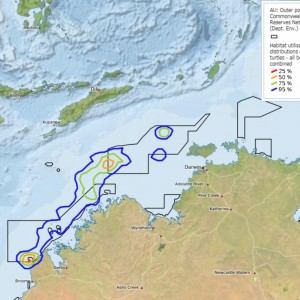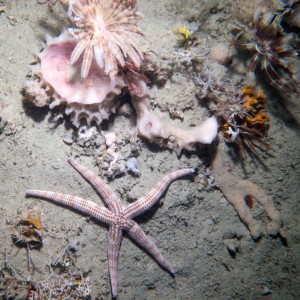Examples of what was found in the benthic sleds. Top: RV Solander crew release the sample from the sled net into the sorting tray on deck. Left: A sled dominated by feather stars, brittle stars and sea stars. Right: A sled dominated by sponges and soft corals
Reefs are incredibly important habitats. They provide a hard surface to which benthic organisms such as corals, kelps and sponges can attach, and once these organisms establish they provide complex 3D structures which can alter the environment by influencing factors such as water flow and the amount of light reaching the seafloor. A healthy reef ecosystem can contain thousands of different species of fish and invertebrates which are well adapted to these unique conditions, and use these habitats for shelter, foraging and recruitment grounds. This crab in the Kimberley Marine Park has made it's home inside a sponge, where it was found hiding with a host of juveniles.
These are examples of different organisms that were sampled during a Western Australian Marine Science Institution (WAMSI) trip to Lynher Bank, approximately 120 nauticle miles north of Broome. This area is an important foraging ground for the Flatback turtles, and the trip focused on collecting samples from the seaflooor and water column to determine what food is available to these protected species. Clockwise from the top left is a crab, fish, seapen, cuttlefish, feather star, crab, jellyfish, octopus and nudibranch. The chemical composition of these samples, and many others, will be tested and compared to that found in flatback turtle tissue to determine if the turtles are eating these organisms.
 by CSIRO
by CSIROThis map shows the home ranges of the 11 tracked flatback turtles during the inter-nesting period in waters off the Kimberley coast in northwest Australia. The coloured contours represent the 25, 50, 75 and 95 % habitat utilisation distributions of the turtles, and the Australian Marine Park boundaries are shown in black. For more information on about this image see Thums et al. 2017.
Istigobius decoratus, known as the Decorated Sandgoby is found on sand patches near reefs.
 by Ian Shaw
by Ian ShawPleurosicya mossambica also known as the toothy goby or the Mozambique ghost goby is found on many substrates, including corals, sponges, giant clams and seaweeds, and can vary colour according to the substrate.
 by Ian Shaw
by Ian Shaw











